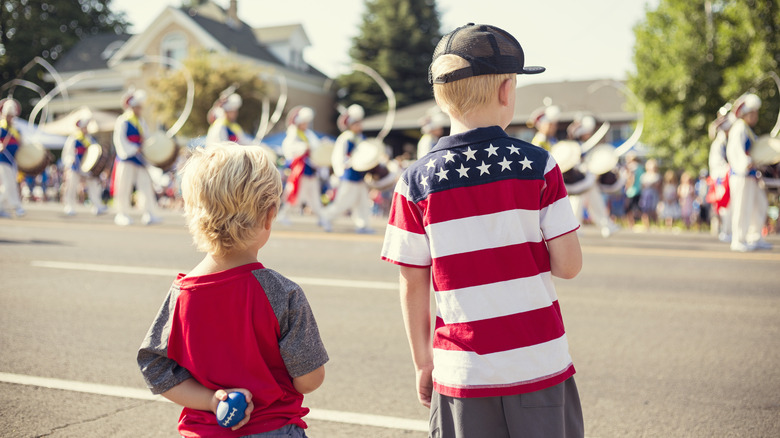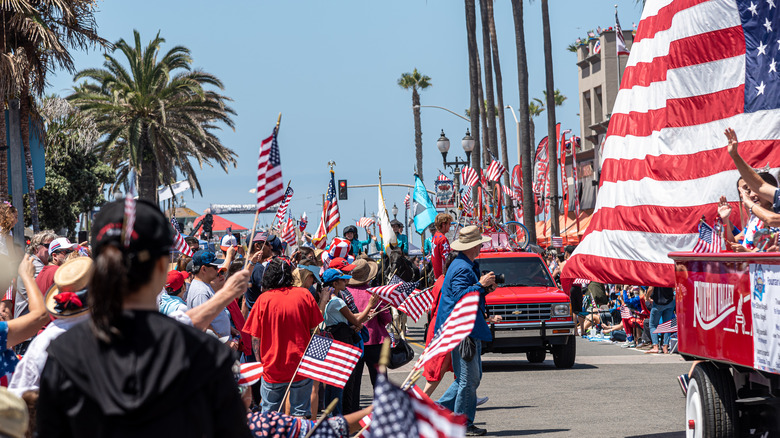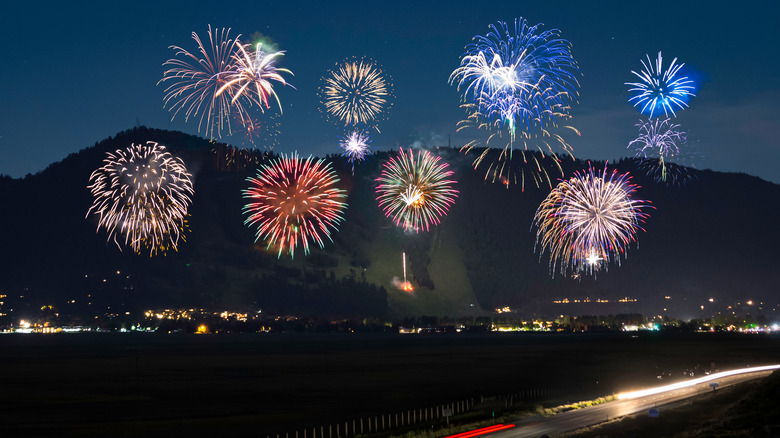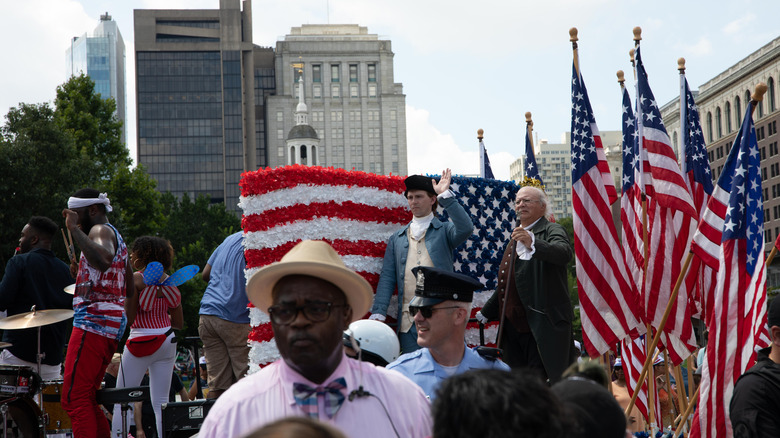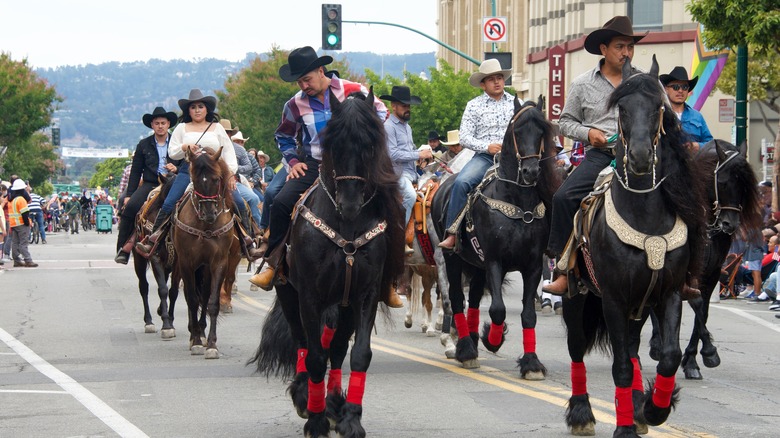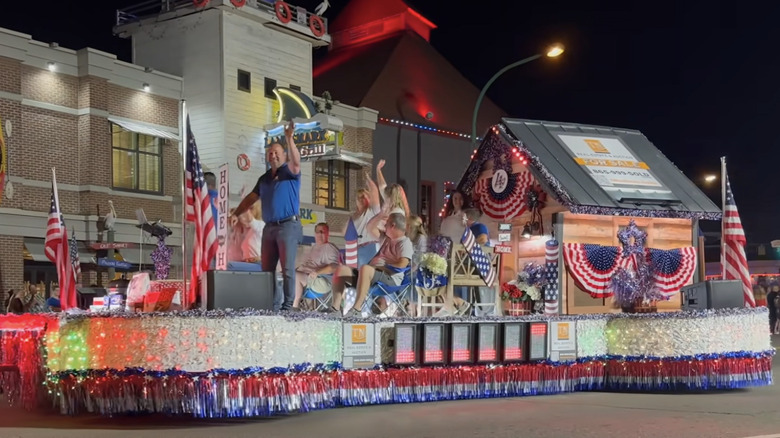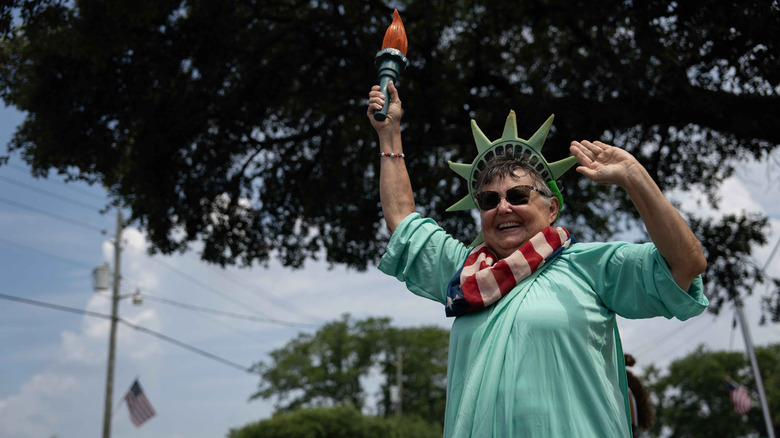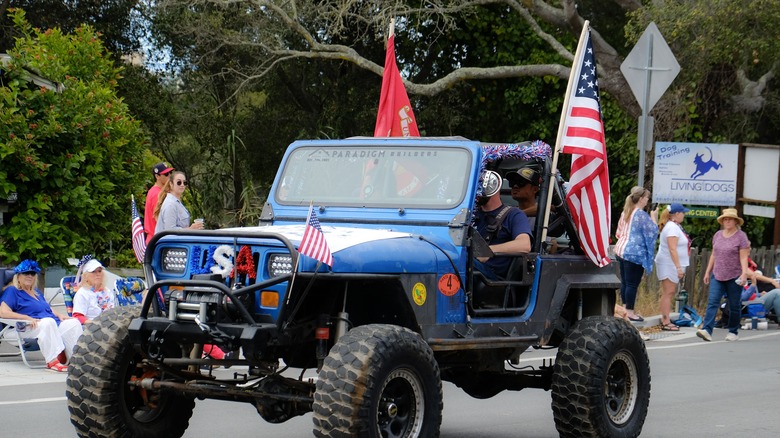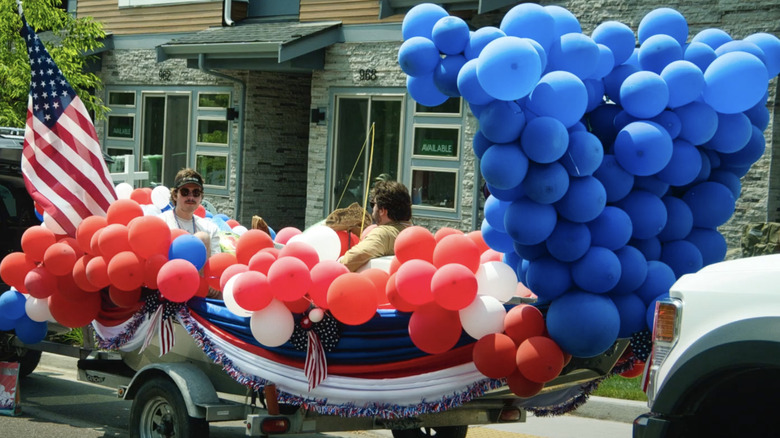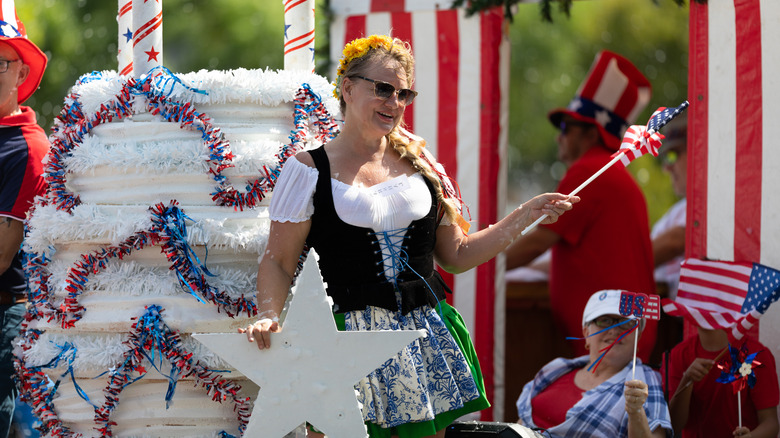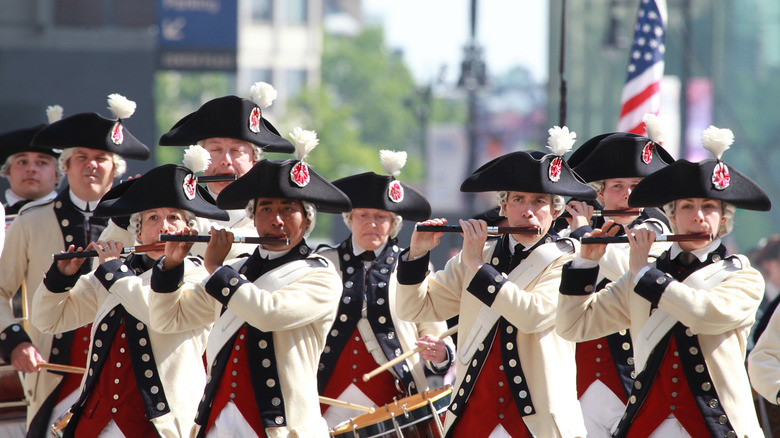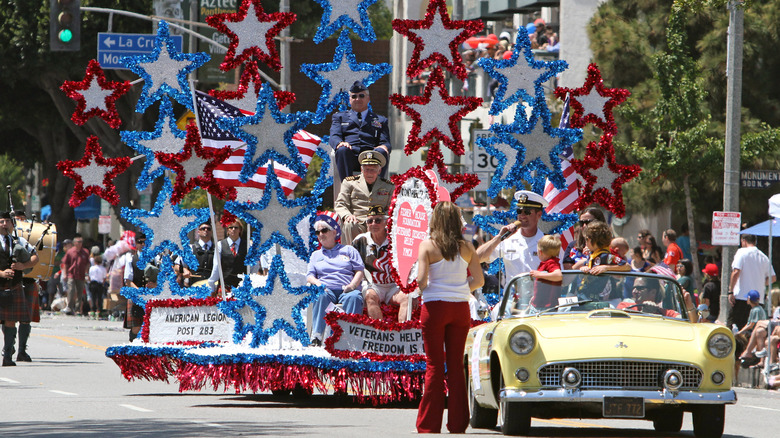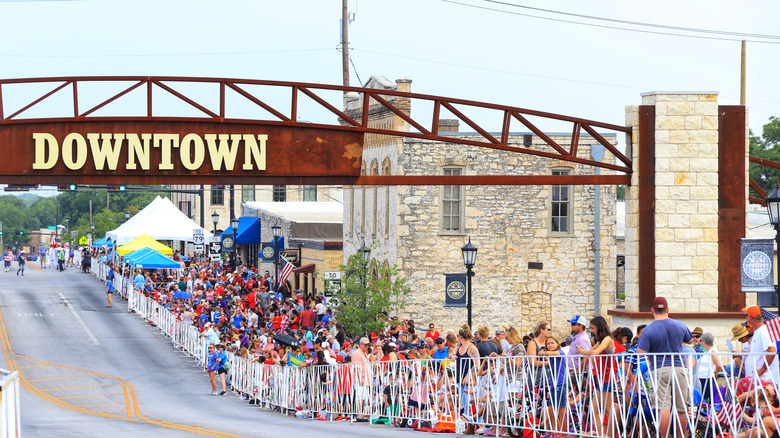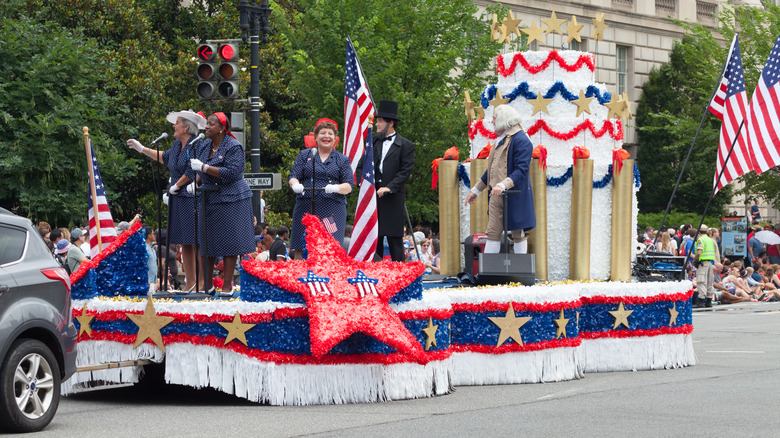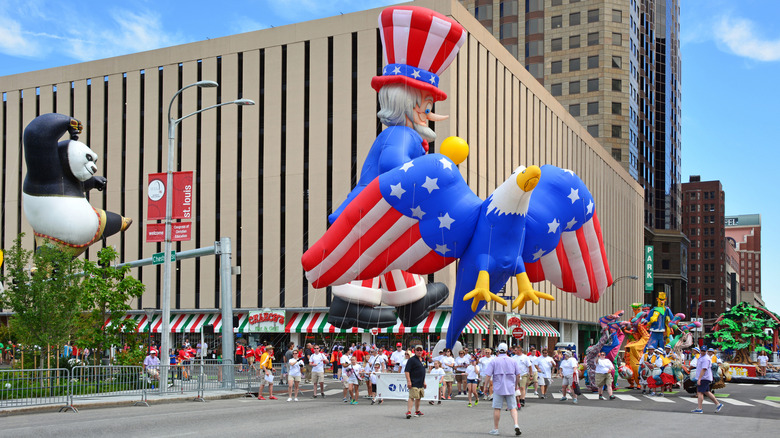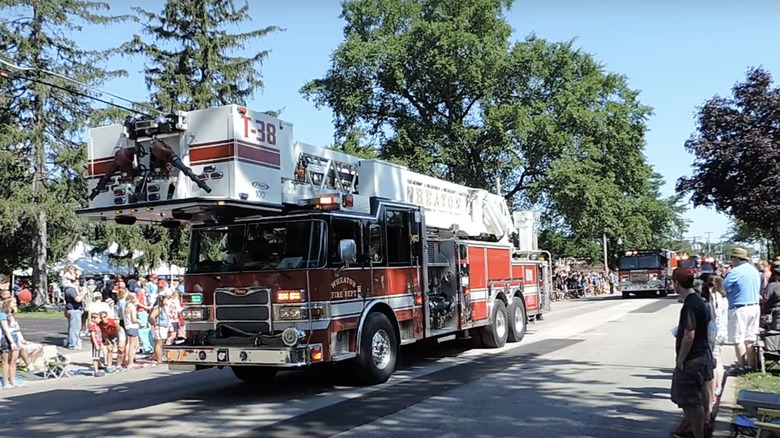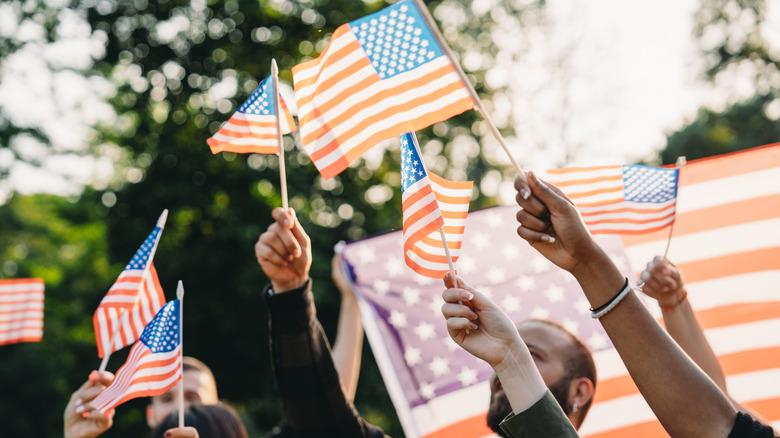15 Biggest 4th Of July Parades Across America
America's birthday is always cause for celebration — and celebrate we do. Every July 4th, communities around the U.S. pull out all the stops to mark Independence Day and salute the history, traditions, and heroes that came before us. While everyone loves the fireworks, parties, and barbecues, the annual Fourth of July parade is one of the most beloved and time-honored traditions in small towns and big cities alike.
These parades come in all shapes and sizes, but it's often the quaint, hometown celebrations that deliver the most powerful patriotic punch. There's no scientific way of figuring out which town or city has the best parade (plus, we're pretty sure most people are biased toward their own local or childhood traditions). However, if you're not one of these people, we've rounded up 15 of the biggest — or most outsized parades compared to the town's size — to help you determine which celebrations are worth attending next July 4th. To create this list, we sourced local media outlets, attendee reviews, and information provided by the planners themselves.
Huntington Beach, California
Huntington Beach's first Fourth of July parade was held in 1904 to mark the first electric passenger train connecting the area to Los Angeles and Long Beach. Electric trains are not quite as celebration-worthy today, but the event's patriotic origins live on and attract an average of 500,000 attendees every year.
The holiday is a five-day affair in Surf City, kicking off with a block party on June 30. Over the next few days, residents and the visitors flocking to the area for patriotic fun can enjoy a carnival, 5K race, decorating contest, fireworks, and, of course, the parade — the latter of which is so spectacular that it's been declared the biggest Fourth of July Parade west of the Mississippi River.
A procession of classic cars, marching bands, military veterans, and local officials stretches down a 2.5-mile route along Pacific Coast Highway. If you want to secure a good viewing point, be aware that competition is fierce. While the parade typically starts at 10 a.m. on July 4, the city itself has had to intervene to restrict the über-enthusiastic from staking out their spot before 7 a.m.
Jackson Hole, Wyoming
Any preceded by all-you-can-eat pancakes is a parade worth attending. Jackson's Town Square offers up unlimited grub for a small fee from 8 a.m. before the Jackson Hole 4th of July Parade begins two hours later. A combination of horses, clowns, and classic cars — all bedecked with red, white, and blue trimmings — circle the town from the Teton County Fairgrounds, through Broadway and Town Square, to Willow Street.
There's a reason why each of these floats seems determined to outdo the last. Every Fourth of July, judges survey the celebrations to choose Jackson's top three float designs of the year. There tends to be a heavy focus on Jackson's ranching history and Western culture in general, so you can expect to see your fair share of cowboys and cowgirls.
If you're somehow not satisfied by the time the parade ends its two-hour route, there's still plenty more celebrations to be had in the area. The parade is followed up by the country's longest-running shootout show in Town Square, the Jackson Hole Rodeo, and fireworks displays in both Teton Village and Snow King Mountain.
Philadelphia, Pennsylvania
Considering both the creation and signing of the Declaration of Independence and the U.S. Constitution took place in Philadelphia, it's no surprise that America's birthplace goes big to celebrate its birthday. Its Salute to America Independence Day Parade (currently sponsored by Wawa) first started in 1993 and is today regarded as one of the best in the entire country — for good reason.
Lavish floats feature appearances from Miss America and America's Outstanding Teen, as well as the usual United States Military units, marching bands, dancers, important historical characters, and more. Unlike a lot of Fourth of July parades, the parade is structured to tell a story, starting with Native Americans and gradually moving through elements that represent the chronological history of all things red, white, and blue. Traveling through 2nd and Market Streets, City Hall, and North Broad Street, this spectacular lasts for around an hour and a half.
But that's just one part of a 16-day festival. Philadelphia's celebrations start with Juneteenth and run until the Fourth of July, which Visit Philadelphia claims is to "tell a more complete picture of freedom and liberty." The lineup typically includes a free outdoor concert on Benjamin Franklin Parkway, with past performers including Demi Lovato, The Roots, Elton John, and John Legend.
Alameda, California
It's been over 45 years since the first Alameda Fourth of July parade — and it's bigger and better than ever. With a route stretching 3.3 miles down Lincoln Avenue that takes a whopping two hours to complete, it's one of the longest processions in the country.
Despite being longer than your average movie, there's not a second where the parade doesn't offer some form of joyfully patriotic entertainment. Spectators can look forward to over 170 floats containing dancers, horses, antique cars, and more. Unsurprisingly, it draws plenty of attention from all over the Bay Area, with 60,000 spectators flocking to the island every year. We recommend getting there way before its 10 a.m. start time; some families have an annual tradition of watching the parade in the same spot, meaning it's not quite as simple as squeezing into the crowd at 9:55 a.m. and hoping for the best.
If you want to experience the route for yourself ahead of time and give back over the holiday, the parade is preceded by a 5K walk which aims to raise money for the Midway Shelter for abused women and children. Other celebrations include the Alameda USS Hornet 4th of July Celebration, a ticketed event at the military museum complete with aircraft tours, food trucks, and a DJ.
Gatlinburg, Tennessee
If you want to maximize the Fourth of July celebrations with a touch of Southern hospitality, Gatlinburg's Fourth of July parade has kicked off at 12.01 a.m. for over 45 years, making it the earliest in the entire country. A combo of elaborate floats, massive balloons, and marching bands roll through the lamp-lit streets of downtown Gatlinburg (which start to fill up with over 80,000 spectators from the evening before) in the early hours of the morning.
Delightful though its floats are, one of the parade's biggest draws tends to be its Grand Marshals. Gatlinburg has historically brought in iconic figures from Tennessee and beyond to lead its midnight parade, including the Harlem Globetrotters, "American Idol" runner-up HunterGirl, and singer-songwriter Emi Sunshine.
The next 23 hours are just as action-packed as the first. Over the day, Gatlinburg hosts the River Raft Regatta, while the nearby town of Pigeon Forge — home to Dolly Parton's Dollywood — hosts the free Patriot Festival just a 15-minute drive away. The day is bookended with the free Gatlinburg Fireworks Finale, which light up the sky above the Space Needle from 11 p.m.
Southport, North Carolina
Southport was once voted "America's Happiest Seaside Town." Its joyous atmosphere made it the obvious choice to host the state's first official four-day Fourth of July Festival back in 1964 — that and the fact that some kind of commemorative procession has existed in the area since the 1700s when local women would take to the streets clad in white to observe Independence Day.
Needless to say, the celebrations have grown a bit since then. Today, the big day starts with a Naturalization Ceremony to celebrate new American citizens and also consist of a Veteran Recognition Ceremony, Arts & Crafts Market, a Shag Contest (as in the "Carolina Shag," a traditional local dance), and not one but two fireworks displays.
The highlight, however, is the morning parade, which honors those who've served our country and features first responders, local bands, clowns, and more. Up to 50,000 attendees (over 10 times the actual population of Southport) cram into the 3.8-square-mile town to be a part of the fun each year, so we recommend making sure you bring plenty of water. Temperatures can typically reach over 90 degrees Fahrenheit in July, and North Carolina is renowned for its humid summers, meaning things can get more than a little bit sticky — and the last thing you want is to miss out on the celebrations because you're laid up with dehydration.
Aptos, California
This Fourth of July parade is so big because, technically speaking, it's so small. The seaside town of Aptos — which is located a few miles east of Santa Cruz — has hosted the "World's Shortest Parade" for over 60 years, packing a route of just 0.6 miles with a spectacle of classic cars, marching bands, and even dogs (a Bernese mountain dog named Birdie was its fluffy mascot in 2023).
Despite its short length, the parade lasts for well over an hour. Tourists and locals alike fill the sidewalks in their thousands to catch a glimpse before attending Party in the Park, a four-hour extravaganza in Aptos Village Park that involves pony rides, food trucks, bounce houses, and a free concert. This is totally free, although the Aptos Chamber of Commerce does recommend making a $5 to help keep the tradition alive for many years to come.
Bainbridge Island, Washington
A leafy jaunt to Bainbridge Island is a good idea at the best of times, but especially the Fourth of July. Located just 35 minutes away from Seattle by ferry, the island has hosted the annual Grand Old Fourth Hometown Parade — dubbed the "Best Small Town Parade in America" — since 1967.
This runs a mile long from Madison Avenue in the early afternoon, in between a schedule jam-packed with live music performances, a pancake breakfast, a beer and wine garden, a classic car show, and a street fair. Kids in particular have no shortage of activities to keep them occupied, with a Kids Zone set up to provide craft stations, a miniature golf course, pony rides, and more.
Highlights of the parade's two hours and 100 floats include classic cars, bagpipes, processions from local community groups, and more stars and stripes than you could possibly count. For an added wholesome hometown touch, there's also a special float dedicated to the Bainbridge Island Educator of the Year.
Arlington, Texas
Whoever coined the phrase "everything's bigger in Texas" may have been thinking about the Arlington Independence Day Parade. An annual tradition since 1965, it's the oldest event in Arlington and the biggest Fourth of July parade in Texas — not to mention one of the biggest in the entire U.S.
Each year has a different patriotic theme with past ideas including "Let Freedom Sing" and "Life, Liberty and the Pursuit of Happiness." Floats featuring everyone from the Dallas Paleontological Society to the local group We Ride Unicycles pass through Center Street, Spaniolo Drive, and Mitchell Street, all hoping to secure one of the event's prestigious prizes, such as the Spirit Award (given to the float that brings the greatest pleasure to and response from the spectators) and the Ruthe Jackson Memorial Award (bestowed upon the most patriotic float).
Unsurprisingly, it's a popular event. Arlington welcomes about 75,000 spectators for its Independence Day Parade each year, with some so determined to secure a prime position that they pitch tents to reserve spots overnight. Locals who live along the route often skip out on the chaos by hosting parade parties on their porches or front lawns instead. If you are determined to get a good view, your best bet is to arrive during the Independence Day Parade Firecracker 5K at 7 a.m. and hold down your spot until the parade begins at 9 a.m.
Boston, Massachusetts
The fight for liberty began in Boston, so it's only right that it hosts one of the biggest celebrations in the country. Boston Harborfest begins on June 30 with an official opening ceremony on Franklin Steps before spending five days honoring not just America but the rich history of Boston Harbor.
Actual Independence Day kicks off at City Hall with a flag-raising ceremony and a 9 a.m. parade to the Granary Burial Ground where wreaths are laid on the graves of patriots. Spectators then follow the parade through Downtown Crossing to the Old State House, where it's followed by a reading of the Declaration of Independence in the same spot where it was first read in 1776. Tradition, heritage, and national pride are very much the focus of Boston's procession, with both veterans and active members of the military, traditional fife and drums corps, and musket-wielding men in historical dress making up the bulk of participants.
Pacific Palisades, California
Nestled between the Santa Monica Mountains and the Pacific Ocean, Pacific Palisades has accumulated decades of sparkly Independence Day traditions. The Pacific Palisades Fourth of July Parade is its most iconic of all, held in the affluent beachside neighborhood every year since 1948.
The beginning of the parade is marked with a flyover of WWII fighter planes. What follows is a lively cavalcade of performers, Mr. and Miss Pacific Palisades, service organizations, and (the obvious highlight) the Patriotic Pups, in which 70 to 100 dogs show off their finest fits. Look out for the annual Kids on Bikes contest, which features an equally adorable army of children cycling down the route in the hopes of winning the award for the best-decorated bike. You should also keep an eye on the skies; one of the quirkiest Fourth of July traditions in Pacific Palisades involves skydivers jumping straight into the middle of the parade.
If you still have energy left at the end of the day, the community hosts a fireworks display at Palisades Charter High School. This requires a small fee to attend, and tickets need to be bought ahead of time.
Round Rock, Texas
The Round Rock Sertoma July Fourth Parade is just one entry on the city's long list of Fourth of July celebrations — including fireworks, carnival rides, a pepper eating contest, pig races, a Sam Bass Shootout reenactment, movies in the park, and skydivers.
Typically starting early to avoid the midday heat, the parade's 1.5-mile route begins on the west side of Mays on Main Street before passing through downtown and continuing to Georgetown Street. Expect giant balloons and helium inflatables, floats and performances from community groups, and processions of classic cars. Awards are handed out to the best of the bunch, which is a win for spectators as this almost always guarantees competitively impressive floats.
The patriotic party continues post-parade at Old Settlers Park, which is home to most of the day's other activities. Like all Independence Day celebrations, things can get crowded. Combined with the fact that temperatures can (and do) surpass 100 degrees Fahrenheit in Round Rock in July, remember to bring plenty of water and stick to the shade as much as possible so you can celebrate safely.
Washington, D.C.
Is there anywhere better to celebrate the Fourth of July than the heart of the country itself? Washington, D.C.'s annual parade takes place on Constitution Avenue from 7th to 17th Street and makes an effort to represent the entire country. Across its fife and drum corps, military and specialty units, drill teams, and VIP guests, it aims to have at least one band or unit from each state.
The parade runs from 11.45 a.m. to 2 p.m. and is streamed online for those who can't make it to the capital. While there's limited seating available on the steps of the National Archives Building, guests are encouraged to arrive early to secure a standing spot (with the end of the route typically less crowded). The day's celebrations end with the PBS Concert at the Capitol Building — featuring the National Symphony Orchestra — and one of the biggest fireworks displays in the country.
St. Louis, Missouri
When it comes to Fourth of July parades, St. Louis is a pro. The city has hosted its America's Birthday Parade for over 140 years, hauling giant balloons and patriotic floats through the shadows of the Gateway Arch for thousands to see every July.
Best described as a mini Macy's Thanksgiving Day Parade, the parade has involved everything from a behemoth inflatable Uncle Sam to cheery cycling clowns handing out free candy. Participants make their way down Market Street from approximately 10 a.m., but you're advised to arrive much earlier if you want a close-up view and to bring your own lawn chair for optimum comfort.
Anyone planning on driving to Downtown St. Louis for the occasion will need to plan ahead; multiple streets close from midnight on July 4th to prepare for the parade. If you stay in the area for the rest of the day, you'll also be able to see the city's annual fireworks display from Gateway Arch National Park at nightfall.
Wheaton, Illinois
For decades, Wheaton residents have come out in their masses for the city's annual Fourth of July parade. Every year's celebration brings a new roster of suitably red, white, and blue floats, each created by local schools, businesses, non-profits, churches, charities, and political parties, all vying for one of the event's 11 awards. Titles are handed out for the likes of Most Patriotic, Best Youth Group, Best Musical, Best Political, Best Use of Theme, and (the most prestigious award) the Carlsons' Best of Show, which is given to the best float overall.
Anyone wanting to check out the newest batch of competitors will need to be ready along the parade route — which runs from Main Street and Hawthorne Boulevard before traveling south on Main Street, turning west onto Union Avenue, continuing south on Wheaton Avenue to Front Street, and ending at Cross Street — when it begins at 10 a.m. Wheaton also holds an annual fireworks display in Graf Park.
Methodology
To create this list and help define the "biggest" Fourth of July parades across America, we considered both parades in big cities and small towns. While large cities may hold larger parades by the numbers, many smaller communities plan outsized celebrations relative to their size. We researched information provided by tourism boards, attendee reviews, and the cities themselves to inform our choices of parades. We considered the time and effort involved, attendance numbers, and each parade's local, regional, or national popularity.
